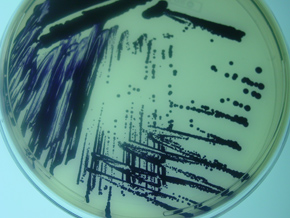

Discovery made by USP researchers opens pathways to the development of antibiotics to fight some types of bacteria, including Streptococcus and Pseudomonas
Discovery made by University of São Paulo researchers opens pathways to the development of antibiotics to fight some types of bacteria, including Streptococcus and Pseudomonas.
Discovery made by University of São Paulo researchers opens pathways to the development of antibiotics to fight some types of bacteria, including Streptococcus and Pseudomonas.

Discovery made by USP researchers opens pathways to the development of antibiotics to fight some types of bacteria, including Streptococcus and Pseudomonas
By Karina Toledo
Agência FAPESP – When pathogenic bacteria invade the bodies of humans or other mammals, the host cells release toxic substances in an attempt to rid themselves of the undesired bacteria. A recent study carried out at the Universidade de São Paulo (USP) revealed one of the mechanisms by which certain types of bacteria defend themselves from this attack.
The results, published in this month’s edition of PLoS One, open new pathways to the discovery of molecules that are capable of inhibiting the bacterial defense system and the spread of infection.
Funded by FAPESP, the study used Chromobacterium violaceum, a microorganism that primarily affects the liver and skin of individuals with compromised immune systems.
“C. violaceum is an opportunistic bacterium. We used it as a model to study pathogenicity because its genome has already been sequenced and it is relatively easy to manipulate genetically,” explained Luis Eduardo Soares Netto, who served as the advisor for the post-doctoral fellowship by José Freire da Silva Neto, which was the basis for the article.
The scientists investigated the production mechanism of an enzyme used by this bacterium to decompose organic peroxides, oxidizing substances that are released by host cells after invasion of the pathogen.
“Organic peroxides cause oxidative stress for bacteria, making it more difficult for them to reproduce and even killing them. To defend itself, the pathogen produces an antioxidant enzyme called Ohr. The production of this enzyme, in turn, is regulated by another protein—which acts as a transcription factor—called OhrR,” said Netto.
When the bacteria are in the baseline state, the OhrR protein binds to the gene responsible for production of the Ohr enzyme. “This is how it impedes the transcription of DNA into RNA and the production of the enzyme,” he said.
However, when the bacterium comes into contact with organic peroxides, OhrR is oxidized and dissociates from the DNA, allowing the production of the antioxidant enzyme. “After Ohr completes its role of decomposing the organic peroxide, another enzyme called thioredoxin comes into action so that the OhrR transcription factor re-binds to the gene and inhibits the production of Ohr,” explained Netto.
This defense mechanism is also present in other types of bacteria, such as Streptococcus and Pseudomonas—both of which cause respiratory illnesses, skin infections and sepsis in humans.
This mechanism is also present in plant pathogens such as Xylella fastidiosa, which causes citrus variegated chlorosis disease (CVC) in Brazilian orange trees and is commonly known as Amarelinho.
Outsmarting the defense system
“Now that we know how the bacterium defends itself, we can think of ways of getting around this mechanism. One possibility would be to inhibit the production of the Ohr enzyme. Another would be to activate the production of OhrR to suppress the antioxidant system,” said Netto.
The first step according to Netto would be to prove in experiments on mice that these genetic procedures would really make it easier for the host organism to combat the pathogen.
The tests are still being standardized, but the idea is to silence the Ohr and OhrR genes in C. violaceum and to evaluate whether this silencing alters the bacterium’s capacity to infect animals.
“Because there are no equivalents of Ohr and OhrR in mammals or plants, if we manage to design a molecule that affects these proteins, it would theoretically have a specific effect on the bacteria without adverse effects on the host,” affirmed Netto.
Although they are still in the preliminary stages, studies are making way for the development of new drugs. “We already know today that the mechanism of action of many antibiotics is the generation of oxidative stress in bacteria. This issue is gaining ground,” he said.
The post-doctoral study is part of a Thematic Project under Netto’s supervision. It is also part of the National Institute of Science and Technology for Redox Processes in Biomedicine (Redoxoma).
Republish
The Agency FAPESP licenses news via Creative Commons (CC-BY-NC-ND) so that they can be republished free of charge and in a simple way by other digital or printed vehicles. Agência FAPESP must be credited as the source of the content being republished and the name of the reporter (if any) must be attributed. Using the HMTL button below allows compliance with these rules, detailed in Digital Republishing Policy FAPESP.




